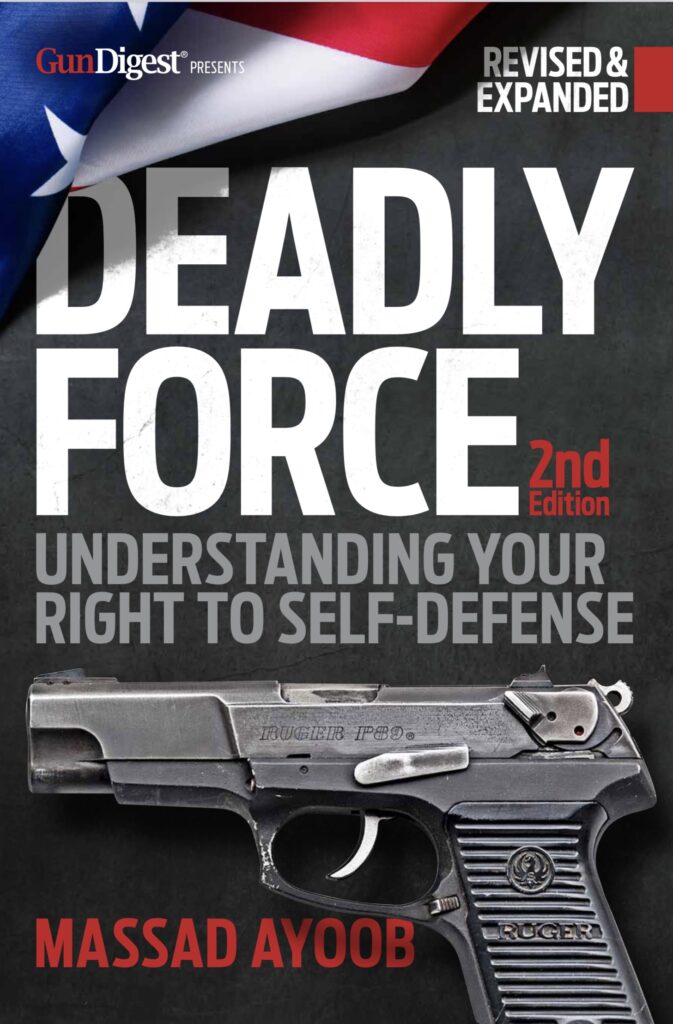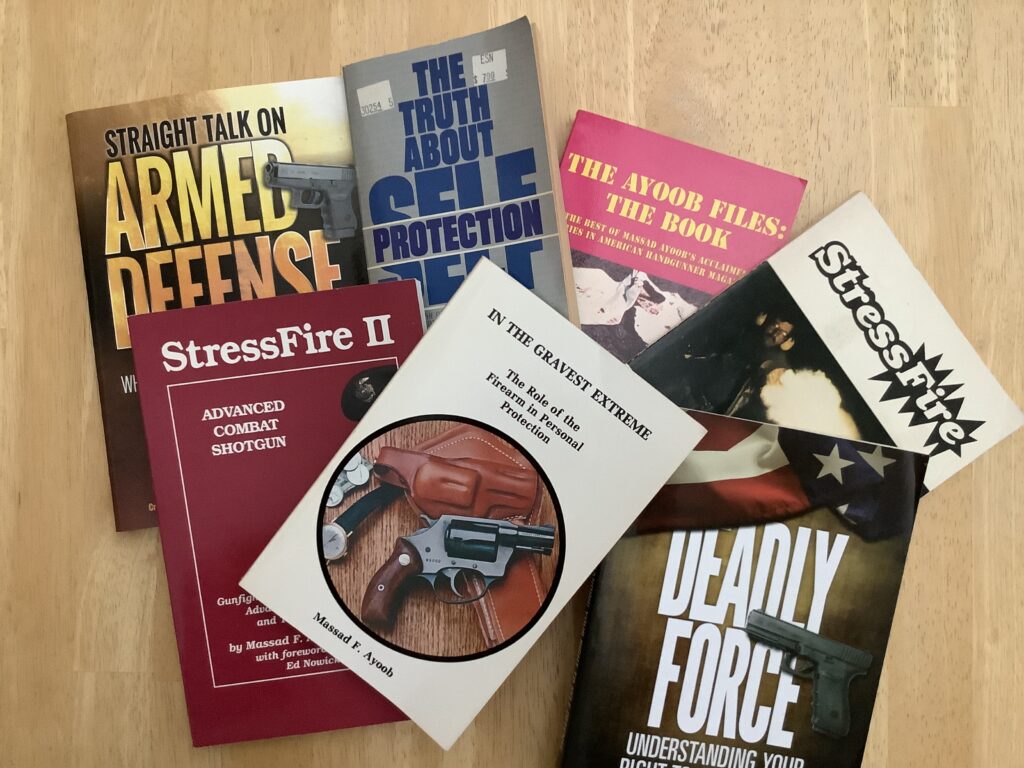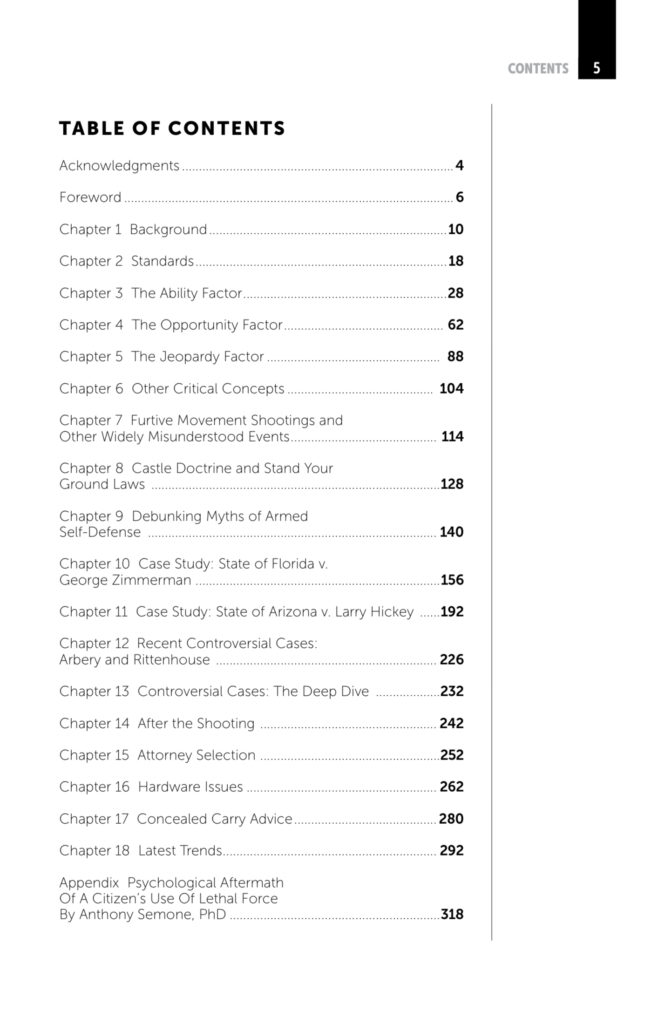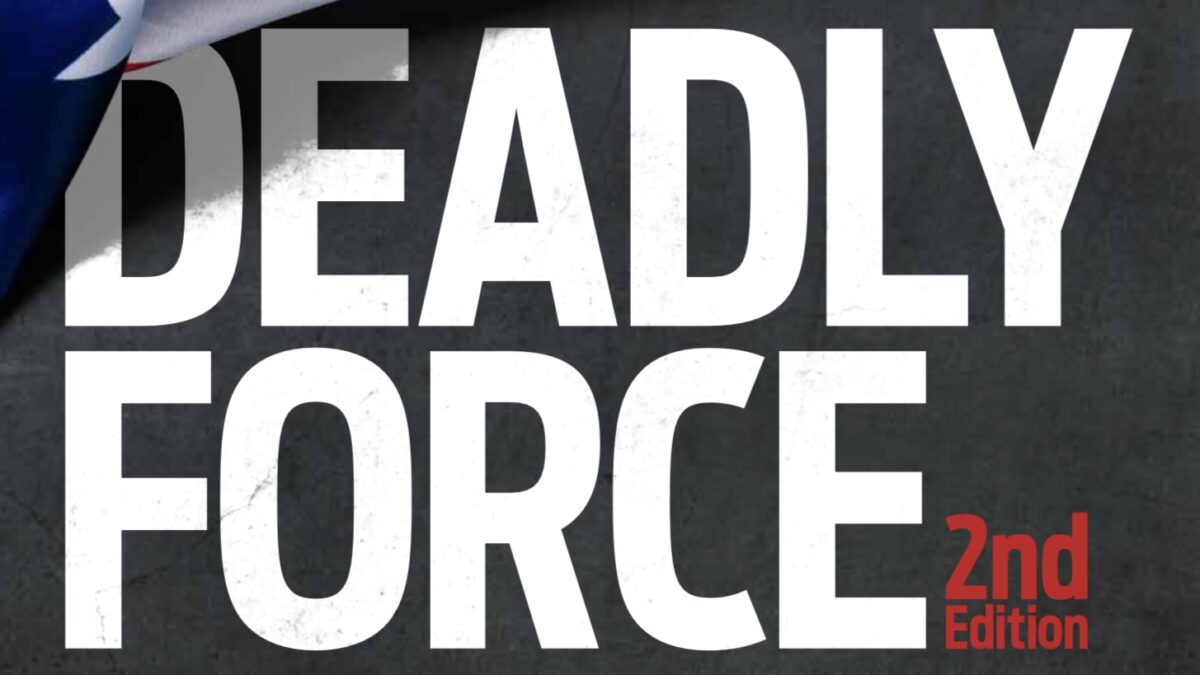One of the many reasons we own firearms is for self-defense. RevolverGuys might be interested in firearms as collector/investment items, historical items, or recreational tools, but I’m willing to bet that self-defense ranks near the top of the food chain, for most of us. They allow us an effective means to defend ourselves, and the things that are important to us, from evil intent, so we make them an important part of our lives.
PRIORITIES
I’ve written before about the Priorities of Survival model that I’m fond of, which was taught to me by writer and trainer Massad Ayoob. In Mas’ model, the most important priority is Mental Awareness & Preparedness, followed by (in abbreviated form) the priorities of Tactics, Skill, and Equipment, in that descending order.

I like to maintain a balance between these priorities when I’m teaching, training, and writing, and as part of that effort, I’d like to review Mas’ latest book, Deadly Force: Understanding Your Right to Self-Defense (Second Edition) for the readers of RevolverGuy.com. In my opinion, it’s a valuable educational tool, and a perfect way to work on that all-important, yet oft-neglected, priority of improving our mental preparation and awareness.
A wealth of resources
The First Edition of Deadly Force, printed in 2014, quickly occupied an important spot on my bookshelf.
As a longtime reader and student of Mas, I was familiar with his prior educational works on self-defense, to include one of the foundational books of the genre, In the Gravest Extreme: The Role of the Firearm in Personal Protection, published in 1980.

In The Gravest Extreme was a groundbreaking effort, and the first serious attempt to explain the complexities of self-defense law and tactics to ordinary citizens, but it was a product of its time, and the self-defense landscape had changed in important ways by the start of the 21st Century. As a result, Deadly Force was an important update for a different America when it was published in 2014, and it became one of my two favorite texts on the subject (the other being Andrew Branca’s excellent study, The Law of Self Defense). In fact, I purchased multiple copies of Deadly Force so I could loan them to friends and students who were taking their first steps in owning a firearm for self-defense.
The updated, Second Edition of Deadly Force was published in 2022, and while I read it immediately upon receipt from the publisher, a number of other projects took precedence over reviewing it in these pages. However, the book is worth our time and effort to explore, even if I’m a bit tardy in doing so, so let’s get to it.
BY THE NUMBERS
The chapters of the Second Edition largely mirror those of the First Edition, with some helpful new additions.

Chapter Twelve in the Second Edition is a short chapter that introduces two significant self-defense trials that occurred since the First Edition was published: The Kyle Rittenhouse Case, and the Ahmaud Arbery Case. In both cases, the actions of the defendants were heavily scrutinized, and two very different verdicts were returned by the respective juries. In this short chapter, Mas introduces how the Totality of the Circumstances in each case was assessed, and how the question of who acted as the initial aggressor played an important role in the outcomes.
Chapter Thirteen in the Second Edition is a more detailed look at the Rittenhouse and Arbery cases, with a thorough discussion of “lessons learned” for the armed citizen. In the study, Mas discusses the (often questionable and/or unethical) tactics used by the prosecution, the trial tactics which helped and hurt the defendants, and important considerations which should shape and effect both the preparations and the response of armed citizens. I found his comparison of the two cases, in which all of the armed defendants were the focus of long gun disarm attempts, to be particularly enlightening.
Chapter Eighteen in the Second Edition is a much-appreciated synopsis of the current trends in the self-defense landscape, to include the increase in prosecutorial “dirty tricks,” their collusion with a media that is hostile to armed citizens and self-defense, and the changing nature of violence in the United States, to include an increase in politically-motivated (and, often, government-sanctioned) mob violence. It’s a no-nonsense look at how the landscape is changing for armed citizens, and how it’s becoming even more difficult to avoid politically-motivated prosecutions for legitimate uses of force in self-defense. As such, it’s more important than ever for armed citizens to understand their responsibilities under the law, and to make good choices when acting in their defense—both in the street, and in the courtroom.
The Appendix in the Second Edition is a powerful piece by Dr. Anthony Semone that’s worth the price of the book, all by itself, as far as I’m concerned. Semone discusses the psychological, legal, and cultural aftermath of deadly force incidents that armed defenders will have to deal with. He doesn’t pull any punches, and isn’t afraid to shine a light on the deficiencies of the legal system (he reminds us it’s not a justice system, but a legal system, since you may not receive justice in the process), or the ways that society will treat a righteous defender unfairly. I think of this chapter as an immunization against these perils, exposing the reader to a small dose of them early on, so they’ll be able to handle them better later on, if encountered. In the best case, Semone’s cautionary tale will influence the reader’s preparations and actions in a way that helps them to avoid the problem to begin with.
In addition to these new chapters, the Second Edition of Deadly Force contains additional updates throughout the book. Most of these are minor (like Mas’ discussion of the trigger on the Glock Gen 5 pistols, which were introduced since the First Edition), but all of them help to update the book with the latest information and guidance for the reader.
AMMO FOR YOUR BRAIN
My First Editions are still valuable tools, but the updated Second Edition of Deadly Force is much better, and it’s displaced them from their spot next to Branca’s book on my bookshelf. It’s simply a more comprehensive, more current discussion of the issues facing us as armed defenders.
I’d encourage all RevolverGuy readers to visit the Gun Digest Store and purchase their own copy of the Second Edition. I think it’s an important contribution to the discussion on self-defense in America, and a valuable tool to help us prepare for the gravest extreme that Mas first wrote about, over four decades ago.
We’re quick to spend our time and money on equipment, because new toys are fun, but if you’re a serious student of self-defense—and if you carry a gun for self-defense, you need to be—I’d highly encourage you to read and carefully consider this book. We ignore the important self-defense realities that Mas writes about in this book at our own peril.
Be safe out there, folks!
*****
Train with revolverguy!
As a reminder, Mike will be teaching a Defensive Revolver class in Northern California in October. See this post for additional details.


Thanks for this review. Did a double take when I saw that cover–I’m currently trying to turn a P85 “sow’s ear” I bought almost 40 years ago into a “silk purse,” or maybe a silk ear. So far I’m failing!
Mas often gets a bum rap from other trainers who forget that he was in on the ground floor of survival tactics, including the aftermath, for LEO and armed citizens alike. “Industry Insider” critical reviews of such firearms as the Smith TDAs and the Model 66 were offset later by the perception that he never met a gun he didn’t like. Rereading “In the Gravest Extreme” is as much a time capsule as, say, “No Second Place Winner.” Both are well worth reading time and again.
Spent 38 years in law enforcement as a DPA and then a peace officer. Seen firsthand how flawed and corrupt the legal system can be, from street level to state and federal appellate courts–including a captive woke legislature.
“Immunization” equals awareness in this context. It won’t kill you, unlike some other jabs, and it will definitely make you stronger.
r
Thanks Lobo, I sincerely appreciate your comments on all the above. There are many opinions about Mas and his work, but I’ve always found value in his observations about self defense law and have appreciated his efforts to inform us about the Ins and Outs of how the system works (or fails to work, in some cases).
Michael Bane has very accurately identified that the self defense landscape has changed in recent years, and what we used to “know” about self defense law and tactics has changed in the age of government-sanctioned political and criminal violence. It’s a confusing and perilous world out there for the armed Good Guy, and we need to stay educated and aware.
Hope you can get that P85 in order. They were a little rough around the edges at times, but always ran well, in my experience, as long as you kept them lubed. I had a friend with one who couldn’t get it to run reliably, but it was bone dry when I inspected it. A few drops of lube had it running 100% afterwards. What seems to be the issue with yours?
Light primer strikes–with a spare hammer I bobbed and fitted, leaving what I believed, based on experience with bobbed hammers in SIGs and Berettas, sufficient mass to reliably fire the cartridges–WW 1152 and S&B 115 FMJ.
I used two different slides, one an original P85 with the Mark II mods, the other a stamped P85 Mk II. (Incidentally, the firing pins differ between those slides. Ruger still stocks some of each.)
Replacing the original hammer solved the problem for now. But the primer indentations are not as consistently deep and pronounced as I’d expect with that barndoor OEM hammer.
Ordered up a DAO hammer and a later issue hammer–which has more visible metal–and will weigh and compare them to the bobbed hammer.
Other problem, still present: unexplained, uncalled fliers.
Now backing out of the rabbit hole–I tend to ramble.
Sounds like quite a project, Lobo! I’m curious . . . did you experience significant problems with the original hammer snagging? It seems that rowel-type design would be pretty friendly, as far as external hammers go.
I’d be curious to know if the OEM DAO hammer was paired with a different (higher rate) spring, in factory production. Does your research indicate the same springs were used on DA and DAO versions?
Unexplained fliers makes me suspect a lockup issue, if you’ve already ruled out the ammo part of it.
Haven’t yet been able to determine what springs were used with the DAO hammer. The Numrich stocking numbers differ slightly, with a “C” for TDA and a “D” for DAO. A P89 DAO spring from evilBay is enroute for testing.
Lockup may be the problem, as the Mk II slide uses a larger link, but I’m seeing no real difference. Maybe a P89 slide, but I’m only willing to go so far down this rabbit hole.
Carrying AIWB 30 years ago or more, I decided that I needed to lighten the trigger, shorten the trigger reach and reduce the overall size, so the hammer spur had to go. Fast forward.
Not all decisions are good ones!
I have this book and read it in 2023. Will read it again soon. I have a lot of respect for Mass’s books. Don’t know many others that can match his grasp of the subject of self defense and the law.
Indeed, Pop Pop. Mas does a great job on that subject, and has for a long time. When I took LFI-I back in the early 90s, we had several lawyers in the class who commented they learned more about self defense law in the class than they ever did in their professional studies. Mas deserves lots of credit for bringing this information to the general shooting public’s attention.
I’d also recommend Andrew Branca’s book, as the companion to Mas’ work. Like Mas, he has the ability to make complex legal issues clear to the “everyman.” Fantastic work, from Andrew.
Massad Ayoob is a self-defense expert whom I’ve followed and paid attention to for decades.
One of the great things about him is his willingness to revise his notions on the subject of self-defense, especially what to do after a shooting fray. For example, telling the police just enough to point out the bad guy (or gal), what he (or she) did, who the witnesses are, and the evidence at hand–then say nothing more until your attorney is present.
Unfortunately, there still are folks out there who insist on saying nothing to law enforcement at the scene and let criminals, or their buddies, present a false story that may carry the day.
Yes! That’s definitely an area where he changed his early opinions, based on his experiences. I think his five-point checklist on what to say during your post-shooting interaction with the police is invaluable!
More people have talked their way into prison than have been sleuthed in by the police. Advise police you are willing to cooperate; HOWEVER, you speak only through your attorney.
Everything YOU say will be used against you. Nothing your attorney says may be used against you. Pick your poison.
Thank you for this! I’m a big fan of Branca’s book too, but never was sure where to start with Ayoob. I do read his magazine columns every chance I get.
I own a couple Ruger P series pistols, would still trust them both, only complaint being small sights, shrinking as I age it seems! The kids will enjoy them I’m sure.
A Hi-Viz fiber optic sight is next. Can’t bring myself to spend 110 bucks or so for Trijicons on a second string pistol, and not sure they’d solve the shrinking sight problem– except in the dark.
I’m just leaving mine stock… I don’t really use them any more, and I will let the youngsters do as they will.
I have read Andrew Branca’s book “The Law Of Self Defense.” A great informative book also.
Note that Branca’s analysis concluded that the actions of the people in the Aubry case were justified.
That can be seen as an weakness of Branca or a failure of the court. Ayoob has thought lots of people were unjustly convicted too. They both deal with the real world as it exists.
I’ve read one or two of Ayoob’s books plus several of his articles in gun magazines over the past four decades and I also read Branca’s book on self defense. I may not be able to recite these books chapter and verse but I do recall a few highlights that I try to abide by to this very day.
Only carry (and use) a stock firearm.
Only load factory ammunition, preferably one used by a law enforcement agency.
Trigger jobs, handloaded ammo, exotic calibers, etc… only makes a Soros funded DA’s job of incarcerating a decent tax payer easier than convicting a violent perpetrator who has a lengthy criminal record.
A retired homicide detective who is currently a criminal defense attorney gave a course in Georgia a few years ago. One of the many points he made was to keep your call to 911 very brief.
State that you were the victim of a crime, give your location and request EMS if warranted. Then hang up! Do not answer the dispatcher who will undoubtedly call back looking for more information (ammunition against you!) The police will eventually arrive (hopefully they were able to hire a few warm bodies- another sad commentary on our wacky society!)
All 911 calls are recorded and an inadvertent slip of the tongue after a traumatic event may undermine your claim of self defense.
As s. bond wisely advises:
Request an attorney immediately and only give a statement as advised by your attorney!
There are so many pitfalls to avoid, so arming yourself with up to date knowledge is very sage advice.
I must obtain a copy a read Massad’s revised book since our society has reversed the roles of good guys versus evil.
Stay safe my brothers and carry a reload.